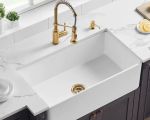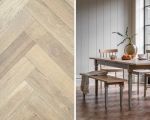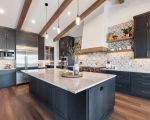- 1-Understanding-Dining-Room-Flooring-Requirements
- 2-Balancing-Aesthetics-and-Functionality
- 3-Evaluating-Durability-and-Maintenance
- 4-Considering-Budget-and-Longevity
- 5-Exploring-Popular-Flooring-Materials-for-Dining-Rooms
- 6-Real-Life-Examples-of-Successful-Dining-Room-Flooring-Choices
- 7-Final-Thoughts-on-Selecting-Dining-Room-Flooring
1. Understanding Dining Room Flooring Requirements
Choosing the right flooring for your dining room begins with understanding the unique demands of this space. Dining rooms experience frequent foot traffic, spills, and sometimes heavy furniture movement, so the flooring must be able to withstand these factors without sacrificing style. In addition, the flooring contributes significantly to the overall ambiance, influencing how inviting and comfortable the space feels during meals and gatherings.
It’s important to recognize that the dining room serves as a transition area connecting the kitchen, living room, and other parts of the home. This means the flooring should harmonize with adjacent spaces to maintain a cohesive design flow. Ignoring these practical and aesthetic considerations can lead to frequent replacements or renovations, costing time and money down the line.
2. Balancing Aesthetics and Functionality
The ideal dining room flooring strikes a balance between visual appeal and everyday usability. While many homeowners desire elegant hardwood or natural stone floors, these materials might not always be the best fit if durability and ease of cleaning are priorities. For instance, a high-gloss hardwood might look stunning but could be vulnerable to scratches or moisture damage from accidental spills.
Conversely, vinyl or laminate options can mimic the look of wood or tile at a fraction of the cost and with added resilience. When selecting flooring, consider the lifestyle and habits of your household. Families with young children or frequent dinner guests might benefit more from flooring options that combine beauty with toughness. This balance helps avoid frustration and ensures the dining room remains both stylish and practical over time.
3. Evaluating Durability and Maintenance
Durability is a critical factor when choosing dining room flooring. The flooring must endure regular chair scraping, dropped utensils, and potential food and drink spills. Some materials, like ceramic tile or engineered hardwood, offer excellent resistance to wear and moisture, making them suitable for active dining areas.
Maintenance requirements vary widely across flooring types. While carpet can add warmth, it is generally discouraged in dining rooms due to its susceptibility to stains and difficulty cleaning food debris. On the other hand, options such as sealed hardwood or luxury vinyl plank require only routine sweeping and occasional mopping to maintain their appearance.
It’s also worth considering the long-term maintenance costs, including refinishing hardwood floors or resealing stone tiles, to ensure your choice remains manageable over years. The key is finding flooring that matches your willingness to maintain it, ensuring it continues to look its best without demanding excessive effort.
4. Considering Budget and Longevity
Budget plays a significant role in flooring decisions, especially for a space like the dining room, where wear and tear can accelerate replacement needs. While it may be tempting to opt for the least expensive materials, investing in quality flooring can save money in the long run by reducing repair and replacement costs.
For example, hardwood flooring often commands a higher upfront price but can last decades with proper care and even increase home value. Meanwhile, more affordable options like laminate or vinyl may offer great initial savings but could require replacement sooner, especially in heavy-use areas.
Balancing your budget with the expected lifespan of the flooring material helps avoid future financial stress. When in doubt, consult with professionals or explore resources like Improvement to find the most cost-effective and durable options tailored to your specific needs.
5. Exploring Popular Flooring Materials for Dining Rooms
Several flooring materials stand out as popular choices for dining rooms, each with unique benefits and drawbacks. Hardwood remains a classic favorite due to its timeless look and ability to be refinished multiple times, extending its life. Engineered hardwood offers similar aesthetics with better moisture resistance, making it ideal for homes with fluctuating humidity.
Tile flooring, particularly porcelain or ceramic, is praised for its durability and ease of cleaning but can feel cold and hard underfoot. For a warmer touch, luxury vinyl plank flooring replicates wood or stone textures while providing softness and excellent water resistance.
Rugs can complement hard flooring to add texture and absorb sound, but it’s important they are durable and stain-resistant to stand up to dining room use. Selecting the right material often depends on personal preference combined with practical considerations like climate, usage, and household composition.
6. Real-Life Examples of Successful Dining Room Flooring Choices
Consider the story of Sarah, who recently renovated her dining room to better accommodate family dinners and social gatherings. Initially torn between hardwood and tile, she chose engineered hardwood after learning it offered the beauty of traditional wood with better moisture resistance. Sarah shared how this choice stood up to spilled wine and enthusiastic celebrations without visible damage, much to her relief.
Another example is a couple in the Midwest who opted for luxury vinyl plank flooring after struggling with pet-related stains on their carpeted dining area. The new flooring not only improved cleanliness but also enhanced the room’s modern aesthetic, impressing guests and making everyday maintenance simpler.
Stories like these highlight the importance of matching flooring choices to lifestyle needs. They also illustrate how well-researched decisions can lead to long-term satisfaction and elevate the dining experience.
7. Final Thoughts on Selecting Dining Room Flooring
Choosing the right flooring for your dining room is a thoughtful process that blends aesthetics, functionality, durability, and budget considerations. Understanding the specific requirements of the dining space helps you narrow down options and find flooring that will complement your lifestyle and home design.
Taking time to weigh different materials, maintenance demands, and real-world performance will save you from costly mistakes and ensure your dining room remains welcoming and stylish for years to come. For personalized product recommendations and expert advice, visit Improvement, where you can explore a wide range of flooring options and services tailored to your home improvement needs.
Ultimately, investing in the right flooring enhances not just the look of your dining room but also the quality of your daily meals and memorable gatherings with family and friends.








